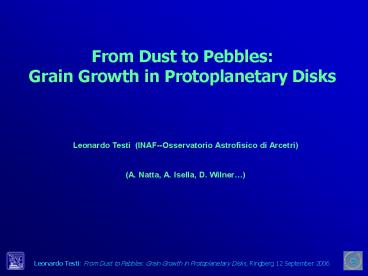From Dust to Pebbles: Grain Growth in Protoplanetary Disks PowerPoint PPT Presentation
1 / 10
Title: From Dust to Pebbles: Grain Growth in Protoplanetary Disks
1
From Dust to Pebbles Grain Growth in
Protoplanetary Disks
Leonardo Testi (INAF--Osservatorio Astrofisico
di Arcetri) (A. Natta, A. Isella, D. Wilner)
2
Overview
- Measuring the wavelength dependence of the dust
opacity coefficient at millimeter wavelengths (?) - Deriving dust properties from ?
- Dust properties as a function of age (?)
- Resolving dust properties in different regions of
the disks
3
Evolution of dust in disks
- Search for the presence of large (cm-size) grains
- The basic idea is to search for mm spectra that
approach the black body spectrum - limit for optically thick disk or grey dust
(sizegtgt?). - F??aa2ß ???ß
- Disks may be optically thick
- Need to go to longer ?
Single dish asub-mm (Beckwith Sargent 1991)
4
Evolved dust in HAe disks
- 1 to 7 mm observations with OVRO/PdBI and the VLA
- Very small, optically thick, ISM grains disk
- Large disk with very large (few cm size) grains
PdBI 1.2 2.7 mm VLA 7mm and 3.6cm amm2.0
ß0.1 a ? 10cm
(Testi et al. 2001)
5
Evolved dust in HAe disks
- 1 to 7 mm observations with OVRO/PdBI and the VLA
- Disk resolved at mm wavelengths
- Disk size
- Surface density profile
- Dust emissivity index
amm2.4 p1.5 ß0.6
(Testi et al. 2003)
6
ß, grain sizes, k and disk masses
- Grain size distributions with very large upper
cutoff explain the observed low values of ß - Opacity and mass is dominated by the upper end of
the distribution - Using the appropriate dust opacity coefficients
Mdust10-2/-3Msun gt original disk mass
0.1-1 Msun - Size distribution need to be cut at observed
size
Small grains dominate
Large grains dominate
7
Large grains in HAe and TTS systems
- Values of ß range from 1.8 to 0.1 (from ISM
grains to pebbles) - No correlation with stellar properties
- No correlation with age
- No correlation with disk surface grains
- Caveat large disks small, biased samples
HAe (Testi et al. 2001 2003 Natta et al.
2004) TW Hya (Wilner et al. 2000Calvet et al.
2002) TTauri stars (Rodmann et al. 2005)
8
Resolving the disk properties
HD163296
(Isella et al 2006)
9
Resolving the disk properties
HD163296
(Isella et al 2006)
10
Open Questions
- Timescale for settling and growth this may be a
fast process, is dust evolution occurring in
Class I phase? - Large grains should be dragged to the central
star on very short timescales, why do we see them
at all? - Resolve the radial dependence of Grain Growth
- Most of the dust mass is contained in pebbles
- Larger bodies, if present, do not dominate the
solid mass of the disk up to 5-10 Myr - Growth to pebbles is very fast, but converting a
significant mass to 1m-size planetesimals seems
more difficult (or requires more time)

